The global atomic system clocks market is valued at USD 512.7 million in 2025 and is slated to reach USD 999.1 million by 2035, recording an absolute increase of USD 486.4 million over the forecast period. This translates into a total growth of 94.9%, with the market forecast to expand at a compound annual growth rate (CAGR) of 6.9% between 2025 and 2035.
The overall market size is expected to grow by nearly 1.95X during the same period, supported by increasing demand for precision timing applications, growing adoption of advanced navigation systems in aerospace and defense sectors, and rising preference for high-accuracy atomic clock technologies across telecommunications infrastructure and scientific research facilities.
Between 2025 and 2030, the atomic system clocks market is projected to expand from USD 512.7 million to USD 715.7 million, resulting in a value increase of USD 203.0 million, which represents 41.7% of the total forecast growth for the decade.
This phase of development will be shaped by increasing adoption of precision timing technologies, rising demand for miniaturized atomic clock systems, and growing emphasis on advanced navigation capabilities with enhanced accuracy characteristics. Aerospace manufacturers are expanding their atomic clock integration capabilities to address the growing demand for satellite navigation applications, defense communication systems, and critical infrastructure timing requirements.
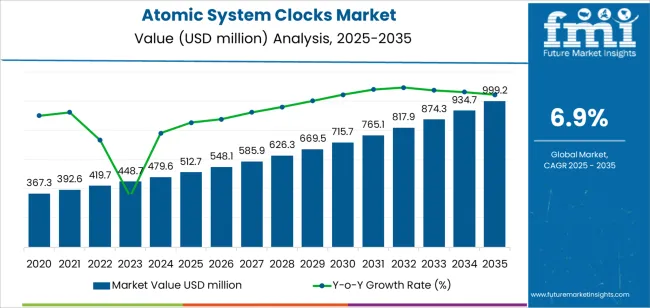
| Metric | Value |
|---|---|
| Estimated Value in (2025E) | USD 512.7 million |
| Forecast Value in (2035F) | USD 999.1 million |
| Forecast CAGR (2025 to 2035) | 6.9% |
From 2030 to 2035, the market is forecast to grow from USD 715.7 million to USD 999.1 million, adding another USD 283.4 million, which constitutes 58.3% of the overall ten-year expansion. This period is expected to be characterized by the expansion of quantum technology integration, the development of chip-scale atomic clocks, and the advancement of optical atomic clock platforms with superior precision capabilities. The growing adoption of 5G networks and satellite constellation deployments will drive demand for atomic clocks with exceptional frequency accuracy and compatibility with advanced communication infrastructure across global operations.
Between 2020 and 2025, the atomic system clocks market experienced steady growth, driven by increasing demand for precision timing solutions and growing recognition of atomic clock technology as essential components for advanced navigation systems, telecommunications networks, and scientific research applications. The market developed as organizations recognized the potential for atomic clocks to enhance timing accuracy while maintaining operational reliability and enabling critical infrastructure synchronization protocols. Technological advancement in miniaturization and power efficiency began emphasizing the critical importance of maintaining frequency precision and long-term accuracy in diverse operational environments.
Market expansion is being supported by the increasing global demand for precision timing solutions and the corresponding need for advanced synchronization systems that can provide superior frequency accuracy and timing precision while enabling enhanced navigation capabilities and critical infrastructure reliability across various aerospace, defense, telecommunications, and scientific research applications.
Modern aerospace operations and telecommunications providers are increasingly focused on implementing atomic clock technologies that can deliver ultra-precise timing references, prevent signal drift, and provide consistent synchronization performance throughout complex networks and diverse operational conditions. Atomic system clocks' proven ability to deliver exceptional frequency precision against environmental variations, enable time-critical operations, and support advanced navigation protocols make them essential components for contemporary space missions and communication infrastructure.
The growing emphasis on satellite navigation accuracy and network synchronization is driving demand for atomic clocks that can support global positioning systems, improve telecommunications performance, and enable automated timing coordination.
Organizations' preference for technology that combines exceptional timing precision with operational reliability and extended service life is creating opportunities for innovative atomic clock implementations. The rising influence of quantum technologies and advanced research applications is also contributing to increased demand for atomic clocks that can provide ultra-stable frequency references, real-time synchronization capabilities, and reliable performance across extended operational periods.
The atomic system clocks market is poised for substantial growth and technological advancement. As industries across aerospace, defense, telecommunications, and scientific research seek solutions that deliver exceptional timing precision, frequency accuracy, and operational reliability, atomic system clocks are gaining prominence not just as specialized timing devices but as strategic enablers of advanced navigation systems and critical infrastructure synchronization.
Rising satellite constellation deployments and expanding 5G network implementations globally amplify demand, while manufacturers are leveraging innovations in miniaturization technologies, quantum frequency references, and integrated timing solutions.
Pathways like chip-scale atomic clocks, optical frequency standards, and space-qualified timing systems promise strong margin uplift, especially in high-precision aerospace segments. Geographic expansion and technology integration will capture volume, particularly where satellite navigation accuracy and telecommunications synchronization are critical. Regulatory support around navigation system requirements, telecommunications standards, and defense timing specifications give structural support.
The market is segmented by technology type, application, end-use sector, frequency standard, and region. By technology type, the market is divided into cesium beam atomic system clocks, rubidium atomic system clocks, hydrogen maser atomic clocks, and others. By application, it covers aerospace, military, telecommunications, scientific research, and others. By end-use sector, it is categorized into government agencies, commercial aerospace, telecommunications providers, and research institutions. By frequency standard, the market includes primary frequency standards and secondary frequency standards. Regionally, the market is divided into North America, Europe, East Asia, South Asia & Pacific, Latin America, and the Middle East & Africa.
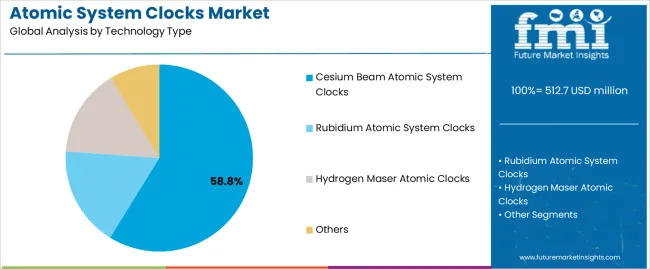
The cesium beam atomic system clocks segment is projected to account for 58.5% of the atomic system clocks market in 2025, reaffirming its position as the leading technology category. Aerospace organizations and telecommunications providers increasingly utilize cesium beam atomic clocks for their superior frequency accuracy capabilities when operating in critical timing applications, excellent long-term precision characteristics, and proven reliability in applications ranging from satellite navigation to telecommunications infrastructure synchronization. Cesium beam atomic clock technology's established frequency reference capabilities and exceptional timing precision directly address the industrial requirements for accurate time-keeping in aerospace and defense environments.
This technology segment forms the foundation of modern precision timing applications, as it represents the atomic clock type with the greatest frequency accuracy and established market demand across multiple application categories and industrial sectors. Manufacturer investments in enhanced cesium beam technologies and improved packaging solutions continue to strengthen adoption among aerospace contractors and telecommunications enterprises. With organizations prioritizing timing precision and operational reliability, cesium beam atomic clocks align with both performance requirements and accuracy objectives, making them the central component of comprehensive timing infrastructure strategies.
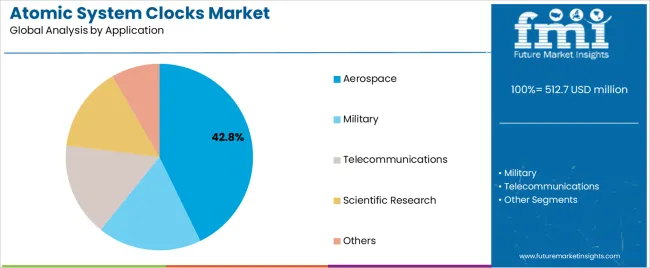
Aerospace applications are projected to represent 42.8% of atomic system clocks demand in 2025, underscoring their critical role as the primary consumers of precision timing technology for satellite navigation, spacecraft operations, and aerospace communication applications. Aerospace operators prefer atomic clocks for their exceptional timing accuracy capabilities, long-term frequency precision characteristics, and ability to maintain synchronization while ensuring reliable navigation performance throughout diverse space missions and satellite operations. Positioned as essential equipment for modern aerospace systems, atomic clocks offer both accuracy advantages and operational reliability benefits.
The segment is supported by continuous innovation in space-qualified atomic clock technologies and the growing availability of miniaturized timing systems that enable reduced size and weight with enhanced frequency accuracy and extended operational life capabilities. Additionally, aerospace organizations are investing in advanced timing architectures to support constellation deployments and mission-critical applications. As satellite navigation demand becomes more prevalent and aerospace precision requirements increase, aerospace applications will continue to dominate the end-use market while supporting advanced space exploration utilization and navigation system strategies.
The atomic system clocks market is advancing rapidly due to increasing demand for precision timing technologies and growing adoption of advanced navigation systems that provide superior frequency accuracy and operational reliability while enabling enhanced synchronization capabilities across diverse aerospace, telecommunications, and scientific research applications. However, the market faces challenges, including high development costs, complex manufacturing requirements, and the need for specialized technical expertise and certification programs. Innovation in miniaturization technologies and quantum frequency references continues to influence product development and market expansion patterns.
Expansion of Miniaturization and Chip-Scale Technologies
The growing adoption of chip-scale atomic clocks, miniaturized timing systems, and integrated frequency references is enabling manufacturers to produce compact atomic clocks with superior portability characteristics, enhanced power efficiency, and reduced size and weight functionalities. Advanced miniaturization technologies provide improved accessibility while allowing more diverse applications and consistent performance across various portable devices and embedded systems. Manufacturers are increasingly recognizing the competitive advantages of miniaturized atomic clock capabilities for market differentiation and commercial positioning.
Integration of Quantum Technologies and Optical Frequency Standards
Modern atomic clock producers are incorporating quantum technology applications, optical frequency references, and advanced measurement systems to enhance timing precision, enable next-generation accuracy capabilities, and deliver breakthrough solutions to research customers. These technologies improve frequency precision while enabling new operational capabilities, including ultra-stable timing references, enhanced measurement accuracy, and reduced operational complexity. Advanced quantum integration also allows manufacturers to support comprehensive scientific research systems and timing infrastructure beyond traditional cesium-based approaches.
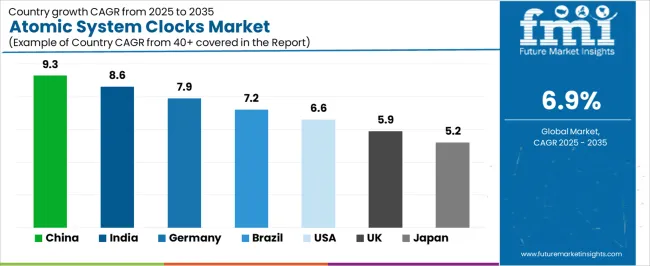
| Country | CAGR (2025 to 2035) |
|---|---|
| China | 9.3% |
| India | 8.6% |
| Germany | 7.9% |
| Brazil | 7.2% |
| USA | 6.6% |
| UK | 5.9% |
| Japan | 5.2% |
The atomic system clocks market is experiencing robust growth globally, with China leading at a 9.3% CAGR through 2035, driven by the expanding aerospace programs, growing satellite navigation development, and significant investment in precision timing technology advancement. India follows at 8.6%, supported by space exploration initiatives promoting atomic clock technology, increasing defense modernization demand, and growing telecommunications infrastructure requirements. Germany shows growth at 7.9%, emphasizing precision engineering excellence and advanced timing technology development.
Brazil records 7.2%, focusing on satellite navigation expansion and defense technology modernization. The USA demonstrates 6.6% growth, prioritizing aerospace innovation standards and timing precision excellence. The UK exhibits 5.9% growth, emphasizing space technology advancement and precision timing development. Japan shows 5.2% growth, supported by high-precision manufacturing initiatives and timing technology concentration.
The report covers an in-depth analysis of 40+ countries, the top-performing countries are highlighted below.
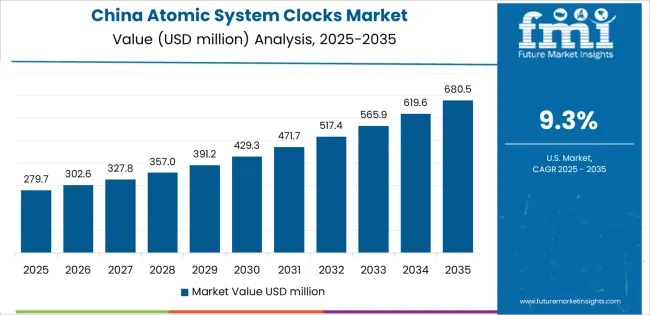
Revenue from atomic system clocks in China is projected to exhibit exceptional growth with a CAGR of 9.3% through 2035, driven by expanding aerospace programs and rapidly growing satellite navigation development supported by government initiatives promoting space technology advancement. The country's strong position in satellite manufacturing and increasing investment in navigation infrastructure are creating substantial demand for advanced atomic clock solutions. Major aerospace organizations and defense contractors are establishing comprehensive timing capabilities to serve both domestic navigation demand and international satellite markets.
Revenue from atomic system clocks in India is expanding at a CAGR of 8.6%, supported by the country's growing space program, expanding government support for aerospace modernization, and increasing adoption of satellite navigation solutions. The country's initiatives promoting space technology and growing defense awareness are driving requirements for advanced timing capabilities. International suppliers and domestic manufacturers are establishing extensive production and service capabilities to address the growing demand for atomic clock products.
Revenue from atomic system clocks in Germany is expanding at a CAGR of 7.9%, supported by the country's advanced precision engineering capabilities, strong emphasis on aerospace technology innovation, and robust demand for high-performance timing systems in space and telecommunications applications. The nation's mature aerospace sector and precision-focused operations are driving sophisticated atomic clock systems throughout the timing industry. Leading manufacturers and technology providers are investing extensively in quantum technologies and miniaturization systems to serve both domestic and international markets.
Revenue from atomic system clocks in Brazil is growing at a CAGR of 7.2%, driven by the country's expanding space program, growing defense modernization initiatives, and increasing investment in satellite navigation development. Brazil's aerospace advancement and commitment to technology modernization are supporting demand for reliable atomic clock solutions across multiple defense and telecommunications segments. Manufacturers are establishing comprehensive service capabilities to serve the growing domestic market and regional aerospace opportunities.
Revenue from atomic system clocks in the USA is expanding at a CAGR of 6.6%, supported by the country's advanced aerospace technology sector, strategic focus on space exploration, and established precision timing capabilities. The USA's aerospace innovation leadership and technology integration are driving demand for atomic clocks in space missions, defense applications, and advanced research applications. Manufacturers are investing in comprehensive technology development to serve both domestic aerospace markets and international specialty applications.
Revenue from atomic system clocks in the UK is growing at a CAGR of 5.9%, driven by the country's focus on space technology advancement, emphasis on aerospace innovation, and strong position in precision timing development. The UK's established aerospace capabilities and commitment to space exploration are supporting investment in advanced atomic technologies throughout major aerospace regions. Industry leaders are establishing comprehensive technology integration systems to serve domestic space operations and specialty aerospace applications.
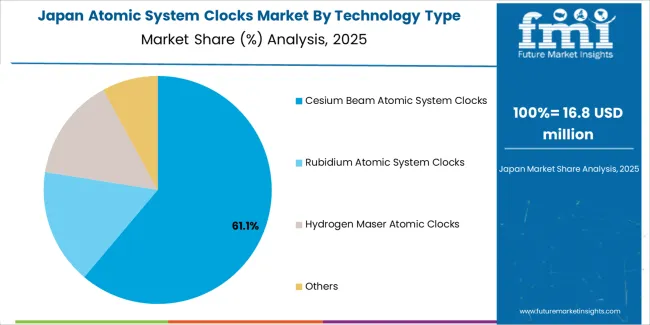
Revenue from atomic system clocks in Japan is expanding at a CAGR of 5.2%, supported by the country's high-precision manufacturing initiatives, growing aerospace technology sector, and strategic emphasis on timing system development. Japan's advanced technology capabilities and integrated precision systems are driving demand for atomic clocks in space missions, telecommunications infrastructure, and high-precision manufacturing applications. Leading manufacturers are investing in specialized capabilities to serve the stringent requirements of aerospace and telecommunications industries.
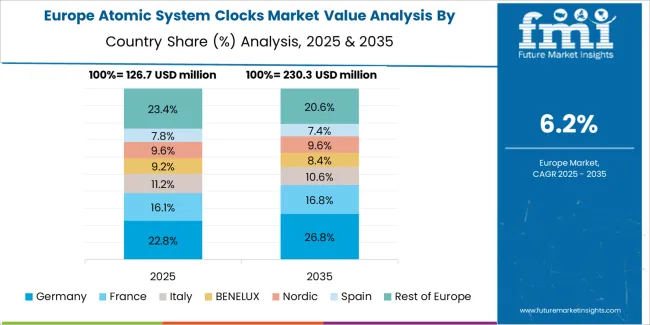
The atomic system clocks market in Europe is projected to grow from USD 102.5 million in 2025 to USD 199.8 million by 2035, registering a CAGR of 6.9% over the forecast period. Germany is expected to maintain its leadership position with a 38.7% market share in 2025, declining slightly to 38.2% by 2035, supported by its strong precision engineering sector, advanced aerospace technology capabilities, and comprehensive timing system industry serving diverse atomic clock applications across Europe.
France follows with a 21.3% share in 2025, projected to reach 21.8% by 2035, driven by robust demand for atomic clocks in space missions, aerospace modernization programs, and satellite navigation applications, combined with established space technology infrastructure and precision timing expertise. The United Kingdom holds a 15.6% share in 2025, expected to reach 16.1% by 2035, supported by strong aerospace technology sector and growing space exploration activities. Italy commands a 11.2% share in 2025, projected to reach 11.5% by 2035, while Spain accounts for 7.8% in 2025, expected to reach 8.0% by 2035.
The Netherlands maintains a 3.1% share in 2025, growing to 3.2% by 2035. The Rest of Europe region, including Nordic countries, Eastern Europe, Switzerland, Austria, and other nations, is anticipated to maintain momentum, with its collective share moving from 2.3% to 1.2% by 2035, attributed to increasing aerospace modernization in Eastern Europe and growing precision timing penetration in Nordic countries implementing advanced space technology programs.
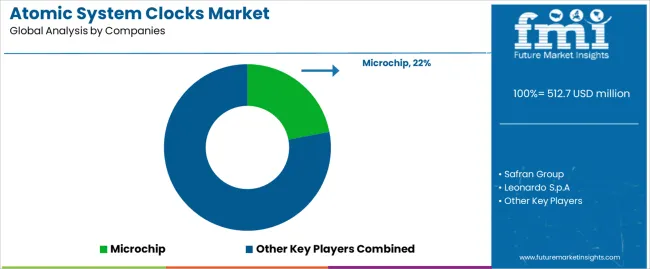
The atomic system clocks market is characterized by competition among established timing technology manufacturers, specialized aerospace suppliers, and integrated precision systems providers. Companies are investing in miniaturization technology research, frequency accuracy optimization, quantum frequency reference development, and comprehensive product portfolios to deliver consistent, high-performance, and application-specific atomic clock solutions. Innovation in chip-scale systems, optical frequency standards, and operational reliability enhancement is central to strengthening market position and competitive advantage.
Microchip leads the market with a strong market share, offering comprehensive atomic clock solutions including advanced timing systems with a focus on aerospace and telecommunications applications. Safran Group provides specialized aerospace timing capabilities with an emphasis on space-qualified systems and satellite navigation platforms. Leonardo S.p.A delivers innovative timing products with a focus on defense applications and aerospace integration services. AccuBeat Ltd. specializes in precision timing solutions and atomic clock technologies for telecommunications and scientific applications. Oscilloquartz SA focuses on telecommunications timing equipment and network synchronization solutions. Orolia Group offers specialized timing platforms with emphasis on aerospace and defense applications.
| Items | Values |
|---|---|
| Quantitative Units (2025) | USD 512.7 m illion |
| Technology Type | Cesium Beam Atomic System Clocks, Rubidium Atomic System Clocks, Hydrogen Maser Atomic Clocks, Others |
| Application | Aerospace, Military, Telecommunications, Scientific Research, Others |
| End-Use Sector | Government Agencies, Commercial Aerospace, Telecommunications Providers, Research Institutions |
| Frequency Standard | Primary Frequency Standards, Secondary Frequency Standards |
| Regions Covered | North America, Europe, East Asia, South Asia & Pacific, Latin America, Middle East & Africa |
| Countries Covered | China, India, Germany, Brazil, United States, United Kingdom, Japan and 40+ countries |
| Key Companies Profiled | Microchip, Safran Group, Leonardo S.p.A, AccuBeat Ltd., Oscilloquartz SA, and Orolia Group |
| Additional Attributes | Dollar sales by technology type and application category, regional demand trends, competitive landscape, technological advancements in miniaturization systems, quantum frequency development, optical atomic clock innovation, and space qualification integration |
The global atomic system clocks market is estimated to be valued at USD 512.7 million in 2025.
The market size for the atomic system clocks market is projected to reach USD 999.2 million by 2035.
The atomic system clocks market is expected to grow at a 6.9% CAGR between 2025 and 2035.
The key product types in atomic system clocks market are cesium beam atomic system clocks, rubidium atomic system clocks, hydrogen maser atomic clocks and others.
In terms of application, aerospace segment to command 42.8% share in the atomic system clocks market in 2025.






Full Research Suite comprises of:
Market outlook & trends analysis
Interviews & case studies
Strategic recommendations
Vendor profiles & capabilities analysis
5-year forecasts
8 regions and 60+ country-level data splits
Market segment data splits
12 months of continuous data updates
DELIVERED AS:
PDF EXCEL ONLINE
Atomic Clock Oscillators Market Forecast and Outlook 2025 to 2035
Atomic Clock Market Size and Share Forecast Outlook 2025 to 2035
Atomic Absorption Spectroscopy Market Size and Share Forecast Outlook 2025 to 2035
Atomic Spectroscopy Market Size and Share Forecast Outlook 2025 to 2035
Atomic Layer Deposition (ALD) Equipment Market Growth - Trends & Forecast 2025 to 2035
Atomic Absorption Spectrometer Market Growth - Trends & Forecast 2025 to 2035
Anatomic Pathology Track and Trace Solution Market Size and Share Forecast Outlook 2025 to 2035
Anatomic Pathology Market Size and Share Forecast Outlook 2025 to 2035
Human Anatomical Models Market
System-On-Package Market Size and Share Forecast Outlook 2025 to 2035
Systems Administration Management Tools Market Size and Share Forecast Outlook 2025 to 2035
Systemic Sclerosis Treatment Market - Trends & Forecast 2025 to 2035
System on Module Market Growth – Trends & Forecast 2025 to 2035
SLE Drugs Market Insights - Growth & Forecast 2025 to 2035
Systemic Mastocytosis Treatment Market
Systemic Infection Treatment Market
5G System Integration Market Insights - Demand & Growth Forecast 2025 to 2035
VRF Systems Market Growth - Trends & Forecast 2025 to 2035
Rail System Dryer Market Size and Share Forecast Outlook 2025 to 2035
HVAC System Analyzer Market Size and Share Forecast Outlook 2025 to 2035

Thank you!
You will receive an email from our Business Development Manager. Please be sure to check your SPAM/JUNK folder too.
Chat With
MaRIA